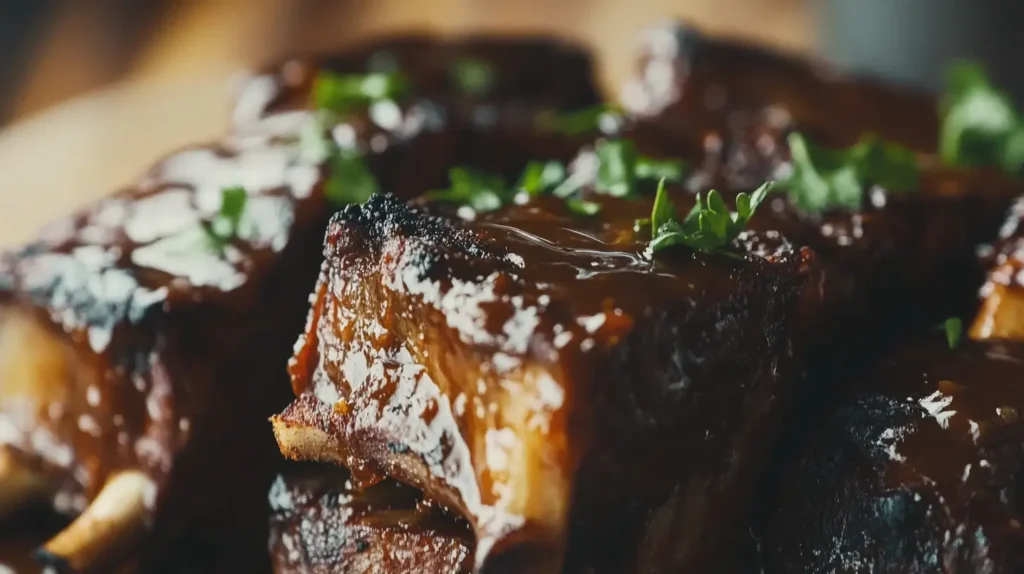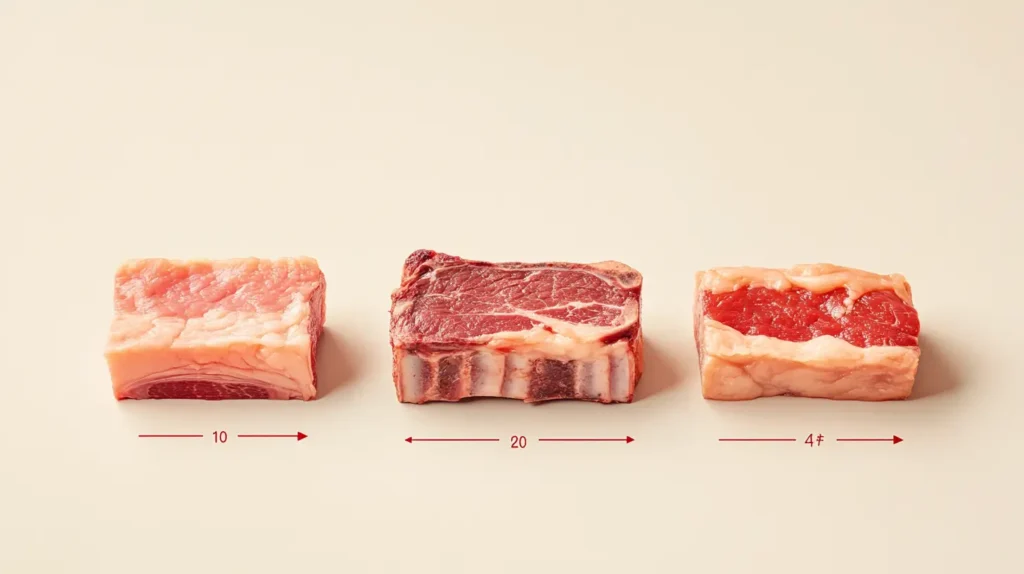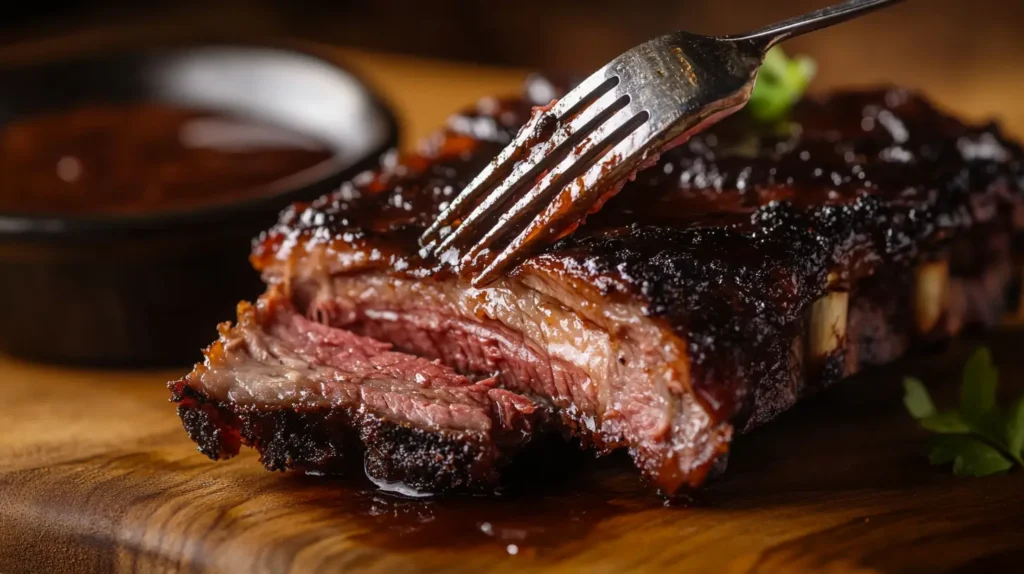Introduction
Overview of Short Ribs
Short ribs are a flavorful and succulent cut of beef that comes from the lower portion of the cow’s ribcage, typically from the chuck or plate sections. Known for their rich marbling and connective tissue, short ribs have a deep beefy taste and a tender, melt-in-your-mouth texture when cooked properly.

Texture and Cooking Importance
Unlike other cuts of beef, short ribs contain a good balance of meat, fat, and collagen, which makes them ideal for slow cooking methods. When cooked low and slow—through braising, smoking, or slow roasting—the connective tissue breaks down, resulting in a juicy, fall-apart tenderness. Because of their unique texture, short ribs require proper preparation and patience to unlock their full potential, making them a prized choice in both home kitchens and fine dining restaurants.
Table of Contents
Understanding Short Ribs
What Are Short Ribs? – Different Cuts (English Cut vs. Flanken Cut)
Beef spare ribs are a cut of beef taken from the lower rib section of the cow, typically from the chuck, plate, or rib primal. They consist of a short portion of the rib bone, surrounded by layers of meat and fat, making them an incredibly flavorful cut when cooked properly.
There are two primary ways Beef spare ribs are butchered:
- English Cut: This is the most common style, where the ribs are cut parallel to the bone, leaving a thick, meaty portion attached to each rib. These are ideal for slow cooking methods like braising, as the long cooking time helps break down the tough connective tissue, resulting in a tender, juicy dish.
- Flanken Cut: In this style, the ribs are cut across the bone into thin strips, leaving small round sections of bone within the meat. This cut is commonly used in Korean-style barbecue (Galbi) and is best suited for grilling or quick cooking methods due to its thinner size.
Each cut has its own best cooking techniques, but both benefit from proper preparation to maximize tenderness and flavor.
The Science of Meat Tenderness
How Collagen and Connective Tissues Break Down Over Time
Short ribs are a tough cut of meat due to their high content of collagen and connective tissues, which play a crucial role in their texture. Collagen is a protein found in muscles and tendons that, when raw, is tough and chewy. However, when cooked slowly at lower temperatures over an extended period, collagen gradually transforms into gelatin, a rich substance that gives the meat its signature tenderness and juiciness.

This breakdown process typically occurs at temperatures between 160°F and 205°F (70°C to 96°C) and requires moisture to properly dissolve the collagen into gelatin. This is why braising—a method that combines slow cooking with liquid—is one of the best techniques for Beef spare ribs.
If cooked too quickly at high heat, the collagen remains tough, resulting in chewy meat. Conversely, with the right amount of time and temperature control, short ribs become exceptionally tender, packed with deep, beefy flavors and a luxurious mouthfeel.
Cooking Methods for Short Ribs
Braising, Slow Cooking, Smoking, Pressure Cooking – How Each Method Affects Tenderness
Short ribs are a tough cut that requires slow, controlled cooking to break down connective tissues and achieve optimal tenderness. Each cooking method has a unique impact on texture and flavor:
- Braising: The most traditional and effective method for short ribs, braising involves searing the meat first, then cooking it slowly in liquid at a low temperature (usually around 275°F/135°C) for several hours. The moisture helps break down collagen into gelatin, resulting in juicy, fall-apart ribs.
- Slow Cooking: Similar to braising but done in a slow cooker, this method uses low heat and extended cooking times (6–8 hours on low) to gradually soften the meat. It’s convenient and ensures consistently tender results with minimal effort.
- Smoking: Smoking short ribs at a low temperature (225°F/107°C) over several hours infuses deep, smoky flavors while slowly breaking down connective tissue. However, since smoking lacks moisture, it’s essential to wrap the ribs (like in the Texas Crutch method) or spritz them regularly to prevent drying out.
- Pressure Cooking: Using an Instant Pot or pressure cooker speeds up the breakdown of collagen by cooking short ribs under high pressure in liquid. This method delivers tender meat in a fraction of the time (about 45–60 minutes), making it a great option for quicker meals while still maintaining rich flavors.
Each method enhances tenderness differently, but the key is maintaining the right balance of time, temperature, and moisture.
Does Cooking Longer Make Short Ribs More Tender?
Ideal Cooking Time, Risks of Overcooking, Balancing Tenderness and Moisture
Cooking time plays a crucial role in achieving perfectly tender short ribs. While longer cooking helps break down tough connective tissues, there is a limit—overcooking can cause the meat to become dry or mushy.
- Ideal Cooking Time:
- Braising/Slow Cooking: 3–4 hours at 275°F (135°C)
- Smoking: 5–6 hours at 225°F (107°C)
- Pressure Cooking: 45–60 minutes under high pressure
- Risks of Overcooking:
- If cooked too long, short ribs can become dry and stringy as all the moisture eventually evaporates.
- In liquid-based cooking (braising, slow cooking, pressure cooking), meat can become too soft and mushy if left for excessive time.
- Balancing Tenderness and Moisture:
- Low and slow cooking is best for converting collagen into gelatin without losing too much moisture.
- Using enough liquid (broth, wine, or sauce) in braising and slow cooking helps retain juiciness.
- Monitoring temperature ensures the ribs stay in the ideal range for tenderness.
The goal is to cook long enough for collagen to break down but not so long that the meat loses its structure. Keeping an eye on texture and moisture ensures the perfect balance of tenderness and juiciness.
Common Mistakes When Cooking Short Ribs
Overcooking, Undercooking, Wrong Temperature, Skipping Resting Time
Cooking short ribs requires patience and precision. Here are some common mistakes that can affect the final texture and flavor:
- Overcooking: While short ribs need a long cooking time, too much heat or time can cause them to become dry and stringy. This is especially true in braising and slow cooking, where extended cooking can turn the meat mushy.
- Undercooking: Since short ribs have a high amount of connective tissue, not cooking them long enough leaves the collagen intact, making the meat tough and chewy. If short ribs still feel firm or resistant when pulled apart, they need more time.
- Wrong Temperature: Cooking short ribs at too high a temperature can cause the outside to dry out before the inside becomes tender. Low and slow cooking (around 275°F/135°C for braising or 225°F/107°C for smoking) allows collagen to break down properly without drying the meat.
- Skipping Resting Time: Just like steak, short ribs benefit from resting after cooking. Resting for at least 10–15 minutes allows juices to redistribute, ensuring the meat stays moist when sliced or pulled apart. Skipping this step can lead to juices running out, leaving dry meat.
How to Tell When Short Ribs Are Perfectly Cooked

Visual, Texture, and Fork Tenderness Tests
Short ribs are ready when they are tender but not falling apart into mush. Here’s how to check for perfect doneness:
- Visual Cues:
- The meat should pull slightly away from the bone but still cling to it. If it has completely fallen off, it might be overcooked.
- A deep, rich color (from browning and caramelization) indicates good flavor development.
- Texture Test:
- The meat should feel soft but hold its shape when gently pressed. If it’s too firm, it needs more time.
- If the meat shreds too easily into fine strands, it may be slightly overcooked.
- Fork Tenderness Test:
- Insert a fork into the meat and twist it gently. If the fork slides in easily and the meat loosens with slight resistance, it’s perfectly cooked.
- If the meat falls apart instantly, it might be slightly overdone.
- If the fork meets resistance, it needs more time to cook.
For braised or slow-cooked short ribs, an internal temperature of 200–205°F (93–96°C) is ideal for tenderness. Monitoring these signs ensures perfectly cooked short ribs that are juicy, flavorful, and tender.
Short Ribs vs. Other Cuts of Meat
How Beef ribs Compare to Brisket, Chuck Roast, and Other Tough Cuts
Beef ribs are often compared to other tough cuts of beef, but they have unique qualities that set them apart in terms of flavor, texture, and cooking methods.
- Short Ribs vs. Brisket:
- Similarities: Both cuts contain a lot of connective tissue and require slow cooking to become tender.
- Differences: Brisket is leaner and has a more uniform grain, making it ideal for smoking and slicing, while Beef ribs have more marbling and bone-in richness, making them perfect for braising or slow roasting.
- Short Ribs vs. Chuck Roast:
- Similarities: Both cuts come from the shoulder/chuck region and contain connective tissue, making them great for slow cooking.
- Differences: Beef ribs have more fat and collagen, resulting in a richer texture. Chuck roast is boneless and typically shredded for stews or pot roasts.
- Short Ribs vs. Beef Shank:
- Similarities: Both are tough cuts that require low and slow cooking.
- Differences: Beef shank has less fat and more sinewy tissue, often used in soups and stews like osso buco, while Beef ribs have a more balanced fat-to-meat ratio, creating a luxurious texture.
FAQs
Answering Common Questions About Cooking Beef ribs
1. Can I cook Beef ribs too long?
Yes. While they need slow cooking, overcooking can make them dry and mushy. The key is to cook them until they are tender but still hold their shape, typically at 200–205°F (93–96°C) internal temperature.
2. Should I sear short ribs before cooking?
Yes! Searing caramelizes the surface, adding depth of flavor. It’s especially important for braised and slow-cooked Beef ribs.
3. How do you make beef short ribs not tough
Achieving tender beef Plate ribs requires patience, the right cooking techniques, and proper preparation. Because short ribs contain a lot of connective tissue, they need low and slow cooking to break down the collagen into rich, flavorful gelatin.
4. What’s the best liquid for braising Beef ribs?
A combination of broth, red wine, or beer works well. These add richness and enhance the beefy flavor.
Conclusion
Cooking short ribs to perfection requires patience, the right method, and an understanding of how connective tissues break down over time. Whether braised, slow-cooked, smoked, or pressure-cooked, each method enhances tenderness differently while infusing deep, rich flavors into the meat.
The key to tender, juicy short ribs lies in low and slow cooking, using the right balance of time, temperature, and moisture. Avoiding common mistakes—such as undercooking, overcooking, or skipping the resting time—ensures that the ribs achieve the perfect melt-in-your-mouth texture.
With the right approach, short ribs transform from a tough cut into an indulgent, flavorful dish that’s well worth the wait. No matter which method you choose, mastering short ribs guarantees a satisfying and delicious meal every time.
